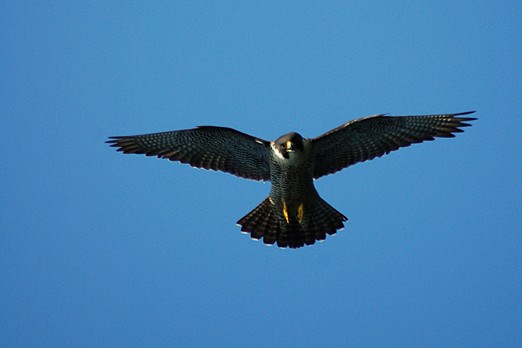Peregrine falcons have come back from near extinction, but biologists still debate whether or not the birds have made a full recovery.
Not long ago the speedy birds couldn’t be found in Ontario. Scientists in the ‘70s started a capture and release program to help give the peregrine falcons a fighting chance. The bird’s recovery was slow and steady, and in 2006 peregrine falcons were taken off the endangered species list and officially categorized as threatened.
A number of factors led to the falcon’s near extinction. Carrier pigeons, a favourite meal of the peregrine, were used to send messages in the Second World War. So, the falcons were shot to ensure messages didn’t become a casualty of lunchtime.
Habitat loss and pesticide use also contributed to the population decline.
The birds’ status came into question in Thunder Bay recently after Horizon Wind Inc. revealed its plans to build a wind farm in a location believed to be part of the falcons’ nesting area.
Mitch Taylor, a biologist who specialized in studying polar bears, but worked on a number of surveys on the birds, says the peregrine falcons have made a recovery to the point that the wind turbines wouldn’t have a significant impact on the overall population.
“There’s nothing in the historical record that would allow one to say that they have recovered to historical levels or exceeded historical levels,” Taylor says. “Both from the demographic and genetic perspective, populations have increased to the point that they are now independently viable.
“It’s documented that those blades spin around and birds that fly around there get whacked by the blades and are killed or injured and die later. Peregrines will likely be attracted to them and yes, if you build a wind farm in a migratory corridor as we have along the north shore of Lake Superior, then you are probably going to be enticing things like eagles and hawks as well as peregrines.”
Taylor, who is against the wind farm project, says the peregrine falcon population is in the range of 40,000 across North America and increasing. Given the success of the species population recovery, he says the peregrine falcon does not fit the definition of an endangered species.
But Brian Ratcliff, a biologist who has studied peregrine falcons in the Thunder Bay district for the past 16 years, isn't so sure about the impact wind turbines may have on the bird’s population.
“There are a lot of assumptions,” Ratcliff says. “I've been working with this bird for 30 years now in the province. We have no historical records and everyone is assuming what sort of numbers you target for.
“Things are looking good right now. The question becomes ‘is this a recovered population or is it still a recovering population?’ One person is going to tell you one thing and another is going to tell you something different. Who's right? No one knows.”
Ratcliff first worked with the birds in the ‘80s during the capture and release program.
He says that the initiative helped recover animal’s population, and now the birds are able to survive in urban environments, including areas like downtown Toronto.
In order to set a bar to tell when the birds have made a full recovery, biologists established 40 historical sites that they believe the birds made their nests on. Ratcliff says if those 40 sites are occupied then it's safe to say the birds have recovered.
The problem is that about 90 per cent of those sites aren't occupied and only three in the Thunder Bay region have falcons nesting, he says.
“Looking at the data if we have a recovered population why are only the eight per cent of the historical nests sites occupied,” he says.
“If we have a recovered population, I would expect half of the historical nesting sites should be occupied.”
He adds that a graduate student in Quebec is doing research on peregrines living near a wind turbine, and says that's the kind of research they need to make sure the wind farm doesn't impact the birds.
